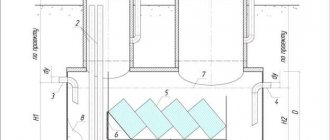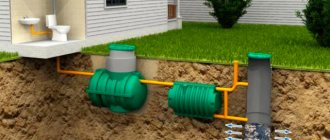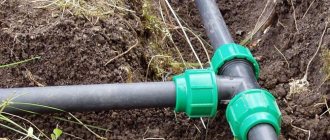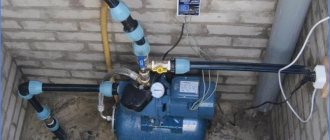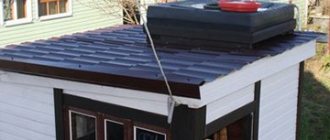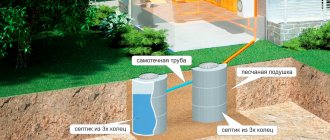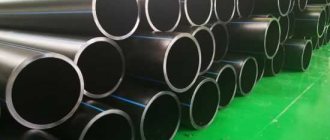Experienced builders and country residents know well that “excess” water on the site is bad. Excess water leads to flooding of the foundation and basement floor, washout of the foundation, flooding of beds, swamping of the area, etc. As a result, in spring, autumn and even summer you cannot walk around your summer cottage without rubber boots.
In this article we will look at:
- How to arrange water drainage on the site.
- How to make a budget storm drain with your own hands.
- Drainage device. How to make inexpensive drainage and drain a wetland.
What it is?
These are complex measures for collecting surface water. This means the manufacture of bends from special pipes, gutters, siphons, sand traps, plugs, storm water inlets and other elements. Its main task is to collect and drain rainwater, melted snow and similar precipitation from the house. Discharge can be carried out into a septic tank or a special container.
Advice! If a ground drainage system is being constructed on a site, then stormwater runoff cannot be directed to one place. As a rule, drainage and stormwater are laid in one trench in parallel, but water is collected in different places. Moreover, the stormwater system is located higher in level.
Video description
How to organize drainage in a country house from sewer pipes is shown in the video:
See also: Catalog of companies that specialize in the installation of water supply, sewerage, drainage and drainage systems
Drainage systems differ in the shape of the pipe section: round and square. Round ones have a more aesthetic appearance and are easier to install. Square ones are cheaper and are used in buildings that have a complex shape and contain a large number of corners and turns.
Depending on the placement of the drainage system, the following types are distinguished:
- Organized external water drainage
. The most common type of drainage, in which water is drained through a system located on the outside of the building. - Organized internal drainage
. Most common in multi-story construction. A peculiarity of this type is the placement of elements of the drainage system inside the object, next to the external walls. - Unorganized water flow
. It is used only in buildings of simple construction with a pitched roof and provides for water drainage directly to the ground.
External and internal drains Source swtor-guild.com
Nuances when installing on the site with your own hands
Must be manufactured in accordance with all prescribed requirements:
- Features of the landscape (slope, location of buildings on the territory, presence of reservoirs, etc.).
- Geological features (nature of the soil, its ability to absorb, etc.).
- The specifics of the building on which the external part of the rainwater drainage system will be installed.
- What is the average rainfall in your area?
- Where and how other utilities are located.
- What will be the total collection and drainage area?
Storm drainage of roads, bridges, junctions
Surface storm water runoff from roads, junctions and bridges must be drained and cleaned. For this purpose, utility systems are used that collect wastewater generated on the surfaces of transport communications, separate the impurities contained in them, and then discharge the wastewater. develops, produces at its own production facilities and installs modern storm sewers for highways, interchanges and bridges, which are highly efficient, easy to operate and maintain.
Advantages of “storm drains” of transport communications from
Storm sewers for roads, bridges and interchanges, designed, manufactured and installed, contain many fiberglass elements. They are characterized by high mechanical strength, resistance to chemical environments, ease of installation and maintenance. The cost of such systems is low, and their service life is
several decades.
Types of storm drainage for transport communications
Storm drainage under the road is a closed type system. It includes a network of underground communications, through which wastewater is first directed to treatment facilities, and then discharged either to sewers or to various environmental objects. Mixed-type storm drains are combinations of open and closed storm drains.
New exit to the Moscow Ring Road from the federal highway M-1 Belarus Moscow-Minsk
Main elements of stormwater drainage on roads, junctions and bridges
Almost every modern storm drainage system on roads, bridges and junctions consists of such basic elements as storm water inlets, gutters, pipeline communications and treatment facilities. All these components together make it possible to collect, purify rainwater, irrigation and melt water, and carry out their timely drainage.
Reconstruction of Borovskoye Highway
Treatment facilities for highways, bridges, interchanges
Treatment facilities for roads, interchanges and bridges are necessary in order to bring the discharged wastewater to conditions that allow it to be discharged. they are implemented based on the principle of gradation. This means that first the wastewater goes through the stage of separation of solid impurities (sand separators), then it enters the oil and petrol separators. The presence of these devices is due to the fact that transport inevitably pollutes storm drains
highways, bridges and interchanges with various petroleum products (fuel, oils). Oil and petrol separators are equipped with coalescent modules, thanks to which organic compounds suspended in wastewater are deposited on their surfaces, become larger and float, forming a film. The post-treatment of wastewater is carried out in a sorption unit, after which the water is discharged onto the terrain, into reservoirs or sewers.
Design and construction of access roads to a sports and entertainment center and a yacht club
SNiP
Mandatory compliance with SNiP and similar standards according to GOST for its manufacture in a small area. Failure to comply with basic requirements will lead to malfunctions in its operation. Thus, the main provisions are set out in SNiP 2.04.03-85 “Sewerage. External networks and structures.”
To achieve the greatest effect, it is extremely important to have the following information at hand, preferably documented:
- Plan of the existing sewer system.
- Working drawings.
- A network profile is made in a longitudinal section.
- A statement of the work that will be carried out.
Installation of road storm drainage in Moscow and the Moscow region
The installation of storm sewers and drainage on road sections makes it possible to cope with the amount of precipitation falling in the capital and region. Neglecting their installation increases the risk of washing out foundations, paths and blind areas. During the low temperature season, roof gutters turn into ice, which swells and destroys the foundations of houses.
High-quality storm drainage under the road helps to avoid expensive sewerage repairs and saves budget funds. Our company offers drainage installation services anywhere in Moscow and the Moscow region.
Storm drains for roads
We can present the engineering system in two versions - linear and point. If we consider point road storm drains, a minimum number of storm water inlets are used. We install them under the drainage system of buildings, and then connect them into a common drainage system. The key elements of this storm drain are sand traps and universal gratings that protect the system.
Linear road storm drainage is complex in its design, but more efficient in operation. It involves draining water from buildings and surrounding areas. Additional channels are connected to storm water inlets to provide a complex of drainage works.
Drafting and standards
When designing and installing highway drainage in Moscow, we take into account the regulations. They prescribe the type of sewerage equipment for certain routes. The engineering network, like the entire complex as a whole, always meets the general criteria according to SNiP.
When the object does not pose a threat to functioning and life support, partial non-compliance with certain provisions is allowed. For other objects, the requirements are strictly met.
- the amount of precipitation in a given area,
- characteristics of soil composition,
- area of future runoff (the parameter can be calculated by calculating the area of roofs and other surfaces that do not allow water to pass into the soil),
- nearby utilities and their planned construction.
With this information, our specialists calculate the approximate volume of water and begin constructing road drainage in this area.
Construction of road sewerage
- hydraulic calculations,
- tracing,
- identification of main system elements and components.
During the tracing process, the location of the nodes and all elements is planned, so that later the water flow can flow independently along a short and free path. The entire territory is divided into swimming pools connected to the sewerage system. After collecting the necessary information, the road drainage of the highway is planned by our designers. The team then begins the main activities of constructing the road drainage system.
By entrusting the installation of storm drains to us, you can be sure of the quality and strict adherence to the terms of the contract. We will correctly calculate the storm drain, select certified material, and use innovative technology in our work. All this allows us to give a long-term guarantee and assure that we are the best among our competitors! In addition, we offer affordable prices for services and always try to get the job done quickly!
Types of rain systems and their design
There are three main types and methods of organizing a drainage system for collecting rainwater:
- Open.
- Closed.
- Mixed.
The first option is the simplest and most inexpensive way to arrange a storm drain. This refers to a system of installed gutters on the roof. Water is collected through them. Then the drainage is carried out through semi-open special grooves.
Cost of water drainage trays
The price of trays for storm drainage varies depending on the material of their manufacture, length, cross-section, width, load and manufacturer, region of Russia. Average cost of storm drainage gutters:
| Tray name | Section length | Internal section | Price, rub.) |
| Standard polymer drainage tray | 1000 mm | 60 mm | 290 rub. |
| Drainage tray Standard | 1000 mm | 160 mm | 440 rub. |
| Standard polymer gutter | 2000 mm | 200 mm | 720 rub. |
| Max polymer tray with cast iron grid | 1500 mm | 220 mm | 1100 rub. |
| Polymer drainage gutter with cast iron grate | 2000 mm | 101 mm | 1200 rub. |
| Concrete tray Standard with cast iron grate | 1000 mm | 140 mm | 930 rub. |
| Standard reinforced concrete gutter with galvanized grating | 1000 mm | 140 mm | 1660 rub. |
| Standard concrete tray with cast iron grate | 1000 mm | 165 mm | 1670 rub. |
| Polymer concrete gutter | 1000 mm | 140 mm | 870 rub. |
| Reinforced concrete drainage tray LAN | 1000 mm | 300 mm | 840 rub. |
| Concrete drainage tray Standardpark | 1000 mm | 140 mm | 370 rub. |
| Composite tray "Ekolot" for Russian Railways | 4080 mm | 500 mm | RUB 8,500/linear meter |
| Composite gutters "Biolot" | 2480 mm | 750 mm | 9500 rub./linear meter |
| Composite tray Ecolot | 2080 mm | 1000 mm | 9000 rub./linear meter |
The price list shows prices for the most popular types of gutters. This will help to approximately calculate the total cost of carrying out work on installing storm drainage systems. High-quality drainage of water from the building allows you to prolong its operation.
Selecting material for the system
Rainwater collection is carried out using:
- pipes;
- wells;
- receiving elements;
- gutters.
When choosing them, it is necessary to take into account some features. An important component of the system are the receiving elements. Funnels are installed on the roof and platforms. They are made from polymer concrete, polypropylene and polyethylene. Their design includes filter baskets in which various inclusions settle. To prevent the release of unpleasant odors from them, some types of receivers have siphons. Their installation is carried out under pipes when organizing a point system.
At the entrance to the building, door trays can be installed, which include a drainage outlet and a protective mesh on top. Plus, this grill allows you to remove dirt from shoes.
Mandatory elements are pipelines, gutters and trays. The most commonly used are polymer pipes and PVC. One important requirement is that all pipe joints must be sealed.
Trays for transporting sediments are made of ordinary concrete or polymer materials. The latter are much simpler and easier to install. Moreover, their smooth internal structure does not create any obstacles to the flow of liquid from the inside. As a result, the possibility of clogging is eliminated. The main thing is to install them with the correct slope.
Wells must be installed to collect precipitation. They must be sealed and reliable. Polymer wells have all the necessary characteristics.
Selection of drainpipes. What parameters should you pay attention to?
These products are quite standard and, apart from the diameter and dimensions, do not differ much from each other. However, if you want to buy a quality pipe, you should understand the features of certain models.
- Material : Almost all drainpipes today are made from either galvanized iron or PVC (polyvinyl chloride). In the first case, we do not have the opportunity to match the pipes to the color and decoration of the house, because such drainpipes are usually not painted, or have a regular silver color. However, galvanized pipes are more durable, unlike colored PVC downspouts (which often crack due to ice and freezing, and can also be easily damaged by, for example, a dog or a child's bicycle). There are also copper drainpipes or those made of other materials, but such products are used very rarely in private housing construction, because such pipes are very expensive;
- Bowl : Drainage pipes are manufactured either as drop pipes (with a "funnel" called a rosette at the top) or as non-rolled down pipes. The latter are more aesthetically pleasing, but their installation requires the use of appropriate gutters and a set of fittings to ensure that they are tightly connected;
- Shape : In addition to the classic round drainpipes, pipes of other shapes are sold in stores. For example, you can buy square downspouts for your home. They are not only original in design, but also more rigid compared to round ones. However, please note that they cannot be secured with classic handles, since they are designed to be screwed onto round pipes. In terms of functionality, there are no major differences, but square downpipes are preferable for aesthetic reasons - in practice this is a matter of taste, but from a technical point of view the differences are minimal.
Did you find this article helpful? Please share it on social networks: Don't forget to bookmark the Nedvio website. We talk about construction, renovation, and country real estate in an interesting, useful and understandable way.
Calculation and arrangement
Design plays an important role in laying out an autonomous system. To calculate everything correctly, the following points must be taken into account:
- Wastewater removal rate.
- The amount of precipitation in your area.
- From what area is collection planned? The roof area is also taken into account.
- How polluted the wastewater will be.
- Features of the landscape and relief of the local area.
- The prevailing temperature in the area.
- Location of the water supply system.
Technology for installing drainage from the foundation of a house
Installation of a drainage system begins with the creation of its schematic image. The site plan indicates all elements, primarily the pipeline. It should be located around the perimeter of the entire building and the entire local area. Professional system installation crews often install pipelines using the herringbone pattern.
First, mark the location of the autonomous sewerage system or well where the water will be directed. From this location there is a direct line of the main drainage pipe to the building. The line is connected to a circle of pipes covering the entire perimeter of the foundation. Then branches follow from the main line, which forms a long and branched pipeline system.
How to do it right?
Installation of the outer part of the storm drain begins with its installation on the facade of the building and the roof. First of all, it is necessary to carry out preparatory work for installing the gutter. To do this, you need to secure the hook.
Advice! Experts recommend using a short hook - one that does not need to be placed under the roofing material. This is explained by the fact that if dismantling is necessary, it will be difficult to remove the long one, since the roofing material also needs to be dismantled.
The gutter should be laid at a slope in one direction. On average, for 6 meters it is enough to make a slope of 25–30 mm. This will be enough for the water to fall well. Plus, the fastening hook should not interfere with the free flow of snow. Therefore, in the direction of the roof slope, the edge of the hook should be lower.
A connector must be used to connect the gutter. It has a special latch and a rubber seal. A plug is installed at the highest point at the end. All water flowing down the gutter should fall into the canadian and funnel. Through them, all precipitation enters the pipeline.
Based on the projection of the roof from the facade, elbows are used to connect the funnel to the vertical pipe. If the roof is hipped, then a tee is installed at the corners to connect the gutter.
As for the wall part of the drain, a bracket and holder are used to secure the pipe. The drain should be located about 50 mm from the wall. An elbow is also installed at the top of the pipe at an angle of 45 degrees and do not forget about the funnel. When the pipe is fixed to the wall, it is necessary to measure the distance from one elbow to the other. Also note that it must fit 80 mm into both links. This means that 160 mm must be added to the actual distance between the knees.
It is necessary to organize drainage from the building. The outlet of the lower elbow should be located at some distance from the foundation. A pipe branch from the building is laid in the ground. This is where all waste should go. For this purpose, a receiver is installed.
Advice! It is recommended to use roofing sealant when connecting the gutter and tees. This is important even if there is a rubber seal.
All above-ground exterior work begins with digging trenches. In the process of digging a pit, it is necessary to immediately organize a slope. The slope of the line should be 10 mm per linear meter, this is the maximum. This will be enough to prevent the pipeline from silting. It is equally important to determine the depth of pipe installation. The peculiarity of such a system is that the water inside does not stagnate, but drains. Therefore, you should not be afraid of freezing. However, it is important to think about the mechanical impact. For example, if the drain will pass in a place where vehicles move, then the depth must be appropriate. Therefore, you can focus on a depth of 70 cm.
Methods of strengthening
Strengthening the ditch with stone masonry
The design of the drainage ditch is a simple, non-durable structure. However, without any special expenses, the drain can be turned into a decoration of the estate’s landscape.
The unformed earthen walls of the drainage system are washed away by water flows and crumble, which leads to clogging and deterioration of the drainage properties of the channel. This problem is easily solved by strengthening the slopes. The choice of the most optimal method depends on the type of soil and the desired result.
- The channel gutter is lined with natural stone.
- Ornamental shrubs or wild grasses with a developed root system that reliably secure the slopes are planted along the edge of the canal.
- Strengthening drainage walls with a three-dimensional geogrid.
- Turfing the upper part of the slope: fastening the pieces of turf is done with special wooden knitting needles.
- The use of geomats consisting of three-layer plastic gratings.
- Application of gabions.
- On clay soils, good results are achieved by using geotextiles covered with a thick layer of sand or crushed stone.
- For a summer cottage, a budget option is acceptable: strengthening slopes with old sheets of slate or car tires.
In all cases, having strengthened the side walls, it is necessary to strengthen the bottom by creating a 5-10 centimeter layer of sand, crushed stone, gravel, rock or broken brick.
How to maintain a storm drain
Designing and building it is one thing. To make it last as long as possible, it needs to be properly maintained. All work in this direction comes down to periodic cleaning. Sediment can form on the walls of gutters, gutters and pipes (for example, stuck leaves from a tree gradually collect silt). This significantly reduces throughput. The cleaning itself is performed mechanically, thermally, chemically or hydrodynamically.
So, the entire service process comes down to the following steps:
- Cleaning roof gutters.
- Cleaning receivers from sludge.
- Cleaning of ground drains.
Permissible load
Based on the specific operation of these products, associated with constant mechanical loads on the structure, this parameter is key. Below is a table of tray classification.
| Type | Permissible load (t) | Scope of application |
| A15 | 1,5 | Summer cottages, pedestrian and park areas, sports grounds, etc. |
| B125 | 12,5 | Private households, parking lots, garage cooperatives, roads for cars. |
| S250 | 25,0 | Car washes, car service companies, gas stations, etc. |
| D400 | 40,0 | Automotive enterprises, industrial zones, transport terminals, as well as roads with high passenger and cargo traffic. |
| E600 | 60,0 | They are installed on drainage systems of warehouses, logistics centers, large industrial enterprises, and berths. |
| F900 | 90,0 | Military bases, airfields, and places where heavy equipment is used. |
Additional tips for those planning to build a drainage system
- If you are thinking about how to make drainage at minimal cost, then pay attention to the materials. So, instead of a plastic tank, concrete rings or brickwork, you can put old car tires in a drainage pit, placing them one on top of the other.
- When a plastic barrel dug into the ground is used to collect wastewater, a concrete slab should be laid on top of it. This will prevent the barrel from possibly being pushed out of the ground in winter.
- To save money, surface drainage can be arranged using old asbestos, cast iron or plastic pipes sawn lengthwise.
- Do not forget: if it is not possible to avoid turns when laying sewer pipes, then the angle in these places should not exceed 45 degrees. Otherwise, the likelihood of blockages increases.
We hope our article helped you decide which drainage system to choose for your dacha. Take installation recommendations into account and get to work!
